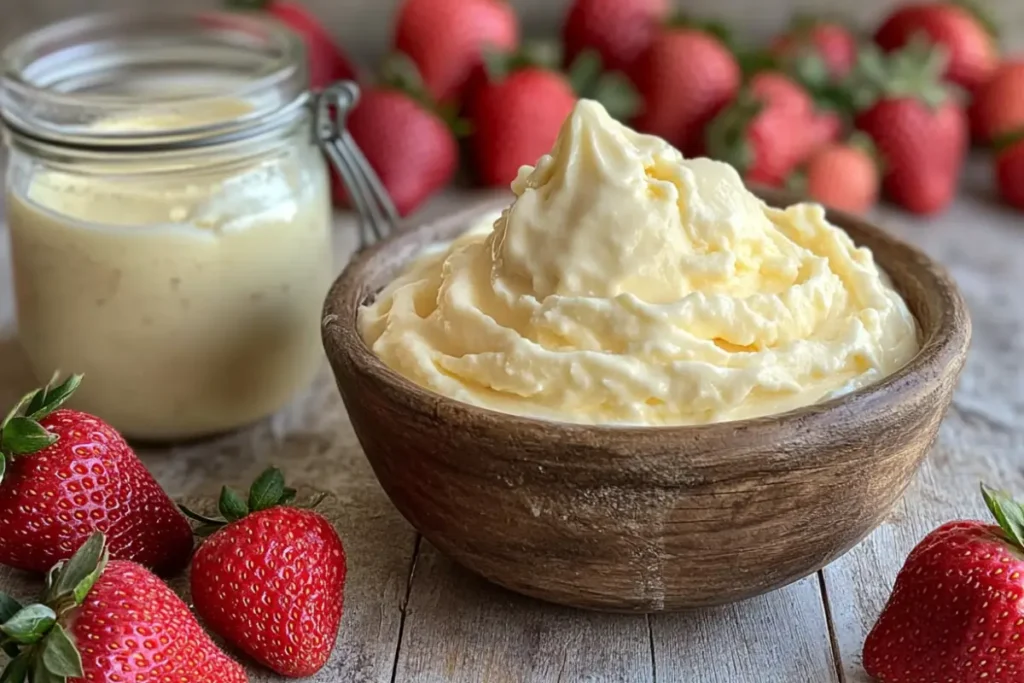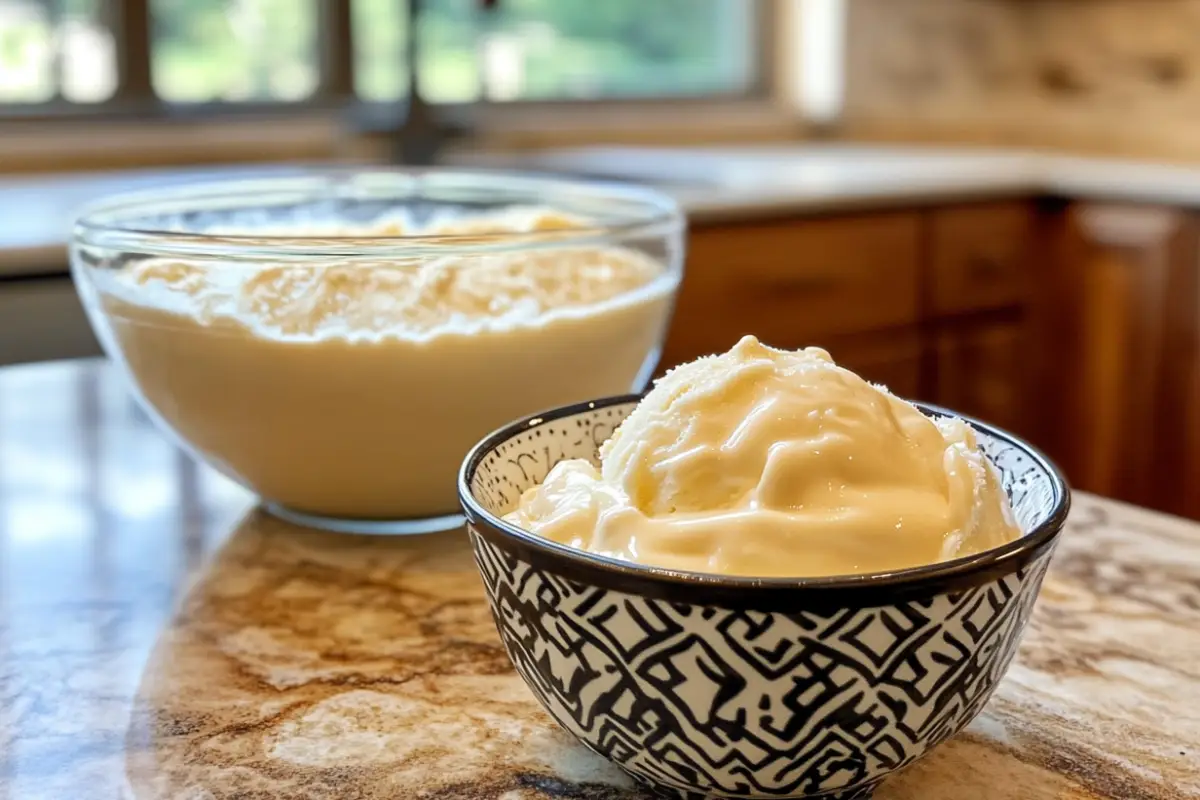Last Updated on February 12, 2025 by Souhail
Have you ever found yourself savoring a scoop of creamy, dreamy ice cream and wondered what makes it so velvety smooth? Or perhaps you’ve marveled at the richness of a custard-based dessert and asked, What is the difference between ice cream base and custard base? These two foundational methods are the unsung heroes behind the frozen treats we all love, yet their differences can completely transform the final result.
At their core, both ice cream and custard bases share the same mission: to create a luscious, satisfying frozen dessert. However, their paths diverge in key ways, from ingredients to preparation, yielding distinct textures and flavors. The ice cream base, with its simple blend of milk, cream, and sugar, is light and refreshing, perfect for showcasing bold, fruity flavors or delicate infusions. The custard base, enriched with egg yolks, offers a richer, more indulgent experience with a silky texture that clings to your taste buds in the most delightful way.
Whether you’re new to making frozen desserts or looking to refine your techniques, understanding these differences opens the door to endless creativity in the kitchen. Both methods have their strengths, and knowing when to use each one is the secret to mastering your favorite recipes.
In this article, we’ll explore the nuances of ice cream and custard bases, giving you all the tools and insights you need to elevate your dessert-making skills. By the end, you’ll be ready to experiment with both styles and create frozen masterpieces that your family and friends will rave about.
Table of contents
- The Key Difference Between Ice Cream Base and Custard Base
- Choosing the Right Base for Your Needs
- Pro Tips for Perfect Ice Cream and Custard Bases
- Exploring Variations of Ice Cream and Custard Bases
- Common Mistakes to Avoid with Ice Cream and Custard Bases
- How Ice Cream and Custard Bases Impact Flavor Development
- FAQs
- Final Thoughts
The Key Difference Between Ice Cream Base and Custard Base
To answer the question, What is the difference between ice cream base and custard base?, it’s essential to examine the role of their ingredients and preparation methods.
1. The Ingredients
The fundamental distinction lies in the use of eggs:
- Ice Cream Base: This typically comprises just milk, cream, and sugar. It’s straightforward, light, and perfect for letting added flavors like fruit or chocolate shine.
- Custard Base: In contrast, this base includes egg yolks. The yolks act as an emulsifier, binding the fat and water in the mixture and contributing a velvety texture.
2. Preparation Techniques
- Ice Cream Base: The ingredients are simply combined and churned, making this option quicker and less labor-intensive. It’s ideal for anyone new to making ice cream.
- Custard Base: Here, you’ll need to cook the mixture gently to thicken the eggs, usually by whisking it over low heat until it coats the back of a spoon. This extra step ensures a smooth, creamy finish but requires a bit more patience and skill.
3. Texture and Flavor
- Ice Cream Base: Lighter and airier, this type of ice cream is often more refreshing. It’s great for flavors like sorbet-inspired concoctions or recipes focusing on vibrant, fruity notes.
- Custard Base: The inclusion of egg yolks results in a richer, denser, and creamier texture. It also has a subtle, buttery undertone that enhances flavors like vanilla, chocolate, or caramel.
4. Freezing and Churning Differences
Custard bases tend to freeze more evenly, producing fewer ice crystals, while simpler ice cream bases may result in a slightly firmer texture.
Choosing the Right Base for Your Needs

When deciding between an ice cream and custard base, consider these factors:
- Time Constraints: If you’re short on time or looking for an easier method, the straightforward ice cream base is your best bet.
- Flavor Focus: Custard bases shine in recipes where richness is key. Think premium vanilla bean ice cream or indulgent chocolate.
- Dietary Preferences: Some prefer avoiding eggs due to allergies or dietary restrictions, making an egg-free ice cream base more suitable.
Pro Tips for Perfect Ice Cream and Custard Bases
Ice Cream Base Tips:
- Chill Your Ingredients: Ensure your milk, cream, and sugar mixture is cold before churning for faster freezing and a creamier result.
- Don’t Skimp on Quality: Use high-quality cream and milk for the best flavor.
- Add Stabilizers: A touch of cornstarch or a natural stabilizer can improve texture without eggs.
Custard Base Tips:
- Temper Your Eggs: Slowly introduce warm liquid into your egg yolks while whisking to prevent curdling.
- Monitor Heat Closely: Use a thermometer and don’t let the mixture exceed 175°F (80°C) to avoid scrambled eggs.
- Strain for Smoothness: Always strain your custard through a fine sieve to remove any lumps.
Exploring Variations of Ice Cream and Custard Bases
Both bases offer incredible versatility. Here are a few popular variations:
- French Custard Ice Cream: Uses more egg yolks for a decadent, creamy result.
- Philadelphia-Style Ice Cream: Egg-free and perfect for light, bright flavors.
- Gelato: Typically uses more milk than cream and fewer eggs, resulting in a denser texture.
- Frozen Yogurt Base: A tangy alternative that skips heavy cream.
Common Mistakes to Avoid with Ice Cream and Custard Bases
Making ice cream and custard bases can be straightforward, but a few common errors can lead to less-than-perfect results. Here are some pitfalls to avoid:
- Curdling the Custard Base: Overheating or skipping the tempering process can result in scrambled eggs instead of a smooth custard.
- Skipping the Chill Step: Not cooling your base thoroughly before churning can lead to an icy texture.
- Incorrect Ratios: Using too much or too little cream, milk, or eggs can throw off the balance of richness and texture.
- Ignoring Quality Ingredients: The flavor of your final product depends on the quality of your milk, cream, sugar, and vanilla.
- Under-Churning: Insufficient churning time can lead to a dense, grainy dessert.
How Ice Cream and Custard Bases Impact Flavor Development

The choice between an ice cream and custard base significantly influences the flavor profile of your dessert:
- Ice Cream Base: The simplicity of milk, cream, and sugar allows added flavors like fresh fruit, chocolate, or vanilla to shine with clarity.
- Custard Base: The richness from egg yolks deepens flavors, making ingredients like caramel or roasted nuts taste more indulgent.
- Flavor Carriers: Custard bases are especially effective at carrying fat-soluble flavors, such as spices and extracts.
- Balanced Sweetness: The added creaminess of custard bases can help balance out sweeter flavorings, while lighter ice cream bases might require additional sugar adjustments.
FAQs
No, not all ice cream recipes require a custard base. Many recipes use a simpler, egg-free base (also known as a Philadelphia-style base). This is ideal for lighter flavors, like fruit-based ice creams, while custard bases are more common for rich, indulgent flavors like chocolate or caramel.
Yes, you can make a non-dairy custard base by using almond or coconut milk and plant-based egg substitutes like silken tofu or cornstarch and water.
Custard bases can curdle if overheated, as egg yolk proteins coagulate at high temperatures. Cook on low heat, whisk constantly, and keep below 175°F (80°C) to prevent this.
Both bases handle mix-ins well. Ice cream bases suit lighter additions like fruit or chocolate, while custard bases pair with rich ones like caramel or brownies.
Yes, you can make ice cream without a machine! Freeze the base in a shallow container and stir every 30 minutes for 3-4 hours. Custard bases work better due to their creamier texture.
An ice cream base is more beginner-friendly because it doesn’t require tempering eggs or cooking. It’s a straightforward mix of milk, cream, and sugar, making it perfect for first-timers. Custard bases, while more advanced, reward patience and precision with a luxurious texture.
Custard-based ice cream lasts longer as egg yolks reduce ice crystals, while simpler bases can become icier. Consume both within 1-2 weeks for best quality.
Final Thoughts
Choosing between an ice cream base and a custard base can seem like a small decision, but it can dramatically impact the flavor, texture, and overall experience of your dessert. While an ice cream base is simple, refreshing, and quick to prepare, a custard base offers a rich, luxurious creaminess that’s perfect for indulgent treats. Both have their merits, and understanding the nuances of each allows you to customize your recipes to suit your taste, time, and occasion.
Whether you’re crafting a light sorbet-style treat with a traditional ice cream base or creating a decadent vanilla masterpiece with a custard base, the choice is yours—and there’s no wrong answer. By mastering the basics and experimenting with these versatile foundations, you unlock endless possibilities for frozen desserts.
If you’re feeling inspired to try your hand at custard-based desserts, we highly recommend checking out our recipe post, The Ultimate Raspberry Swirl Custard Base for Every Dessert. This crowd-pleasing recipe showcases the richness of a custard base while incorporating a vibrant raspberry swirl that’s as delicious as it is visually stunning. It’s a perfect starting point for anyone looking to elevate their dessert game with a versatile, flavorful custard base.
No matter where you start, the world of ice cream and custard bases is an exciting journey filled with creativity and flavor. So, grab your whisk, your favorite ingredients, and a touch of curiosity—your next frozen masterpiece awaits!

